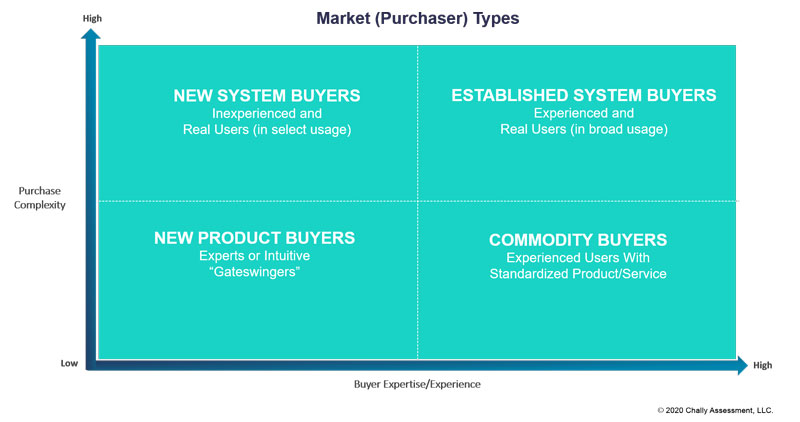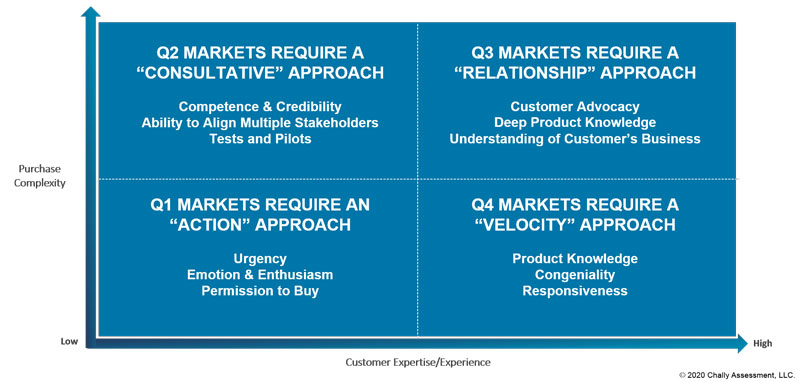How to Align Your Sales Talent with Buyer Needs
One of our specialties at Chally is helping companies use sales assessment analytics to find, hire, and develop sales talent.
Not a day goes by without us hearing a client say they need fewer farmers and more hunters. While this may be true for some organizations, we find that this simplistic and binary perspective can limit sales growth. The fact is that sales is not either or – not hunting or farming. Our research shows that there are at least 12 different types of selling roles and each is effective in different situations.
When growing or transforming their own sales organizations, most people don’t take the time to step back and think about the situation from the buyer’s perspective or from the market’s point of view. As a result, too many organizations oversimply and end up hiring sellers who don’t produce. Often this failure isn’t a matter of hiring the wrong person – it’s hiring for the wrong role in the first place.
Over the years we have developed, tested, and refined a framework that can help clients better design their sales organizations and align their sales role with the needs of their buyers. Most clients end up realizing that they need multiple roles and that simply replacing all their farmers with hunters can be a recipe for disaster.
To save you from making these mistakes, this blog will introduce you to four steps you should take before you start hiring sales talent.
Step 1: Identify your Market Type
Your market type is based on how complex your offerings are and how experienced your buyers are. For ease of application, we’ve sorted market (buyer) types into four quadrants. The quadrants are based on two different aspects. One axis is solution complexity and the other axis is your buyer’s experience with products, services, or solutions like yours.

In many cases, you may see your market type changing based on where your offerings are in the Product/Solution Lifecyle. If you’re looking at this from a market perspective, a lot of times what we see here is that offerings move follow a bell curve.
- Truly new products or services are typically purchased either by technical experts who must buy new technology to remain expert or by visionary “gate-swingers” who are attracted to the idea of being on the cutting edge.
- Once a product or service gains traction, companies, their partners, and even competitors may start to build ancillary products. As a result, the offering moves from a single product or service to a system of interconnected components – often called a solution. New solution or system buyers tend to be inexperienced end users. They need help seeing and making the whole solution or system work in their environment.
- Once solutions become more established and well-known, you will likely see that you have more competitors in your space. Buyers become experienced and knowledgeable (and often more controlling). They know that you need them more than they need you and will often begin to demand customization and high levels of service from you in order to gain and retain their business.
- As time goes on, you get into the lower right side of the quadrant which is commonly thought of as the commodity space. Commodities buyers have become so totally experienced with a product or service that the purchase and usage are completely standardized and routine.
Step 2: Align Your Selling Approach to Your Market Type
Step #2 of our method is all about matching your sales approach to what buyers in that quadrant need in order to make a purchasing decision. Research by Chally, has found that buyer need is largely driven by the two factors that we discussed above – the complexity of the solution and the experience or expertise of the buyer.

- Technical trend-setters and influential gate-swingers in Quadrant 1 need an emotional appeal coupled with a sense of urgency in order to buy. Effective selling to these buyers requires an approach that emphasizes how new, exciting, interesting, and better your offerings is. We use the term “action” approach to describe the selling activities that are most effective for this quadrant.
- Inexperienced but real users in Quadrant 2 have both substantial technical purchasing and application support needs. Because you are now selling a system or integrating products, sales often involve multiple people within the customer’s organization. Their needs must be met by a “consultative” approach that starts in sales and continues throughout delivery. Educating clients and working side by side with them to architect and implement are key activities to the consultative approach. Sellers in this quadrant also need to be able to align multiple stakeholders and keep the sale moving forward.
- Customers in Quadrant 3 continue to have high technical and application support needs. However, they are now more experienced and are often more demanding. Effective selling to this market often involves distinguishing yourself, not just on your expertise, but by how you serve your customers, the depth of your product knowledge, and how well you build long-term, personal connections. We call this the “relationship” approach. Companies and sellers who do well in this market demonstrate deep knowledge of their customer’s business and are seen as advocates who get things done for their customers.
- Only two needs typically predict commodity buying behavior in Quadrant 4: price and convenience. Selling in this space requires responsiveness and the ability to differentiate your product or offering from your many competitors without introducing a lot of complexity. Decisions are often either/or and result in an immediate transaction. We call the combination of presenting options and supporting quick decisions in this quadrant the “velocity” approach.
Now that you understand your markets and how to best approach them, you can start to think about the sales roles within your organization.
Step 3: Select Specific Sales Roles Based on Sales Approach
Step #3 is about how you choose or design sales roles so that selling actions are deliberately aligned with the needs of your buyers.
Action approach sales roles in Quadrant 1 are designed to create a sense of excitement and urgency and get to a quick close. In some organizations, Quadrant 1 roles are designed to be outside or “field sales” positions where much of the selling is done in person. Other roles in this quadrant may be performed over the phone and may involve closing the sale with one or two calls or BDR type roles that close for a next step such as a meeting.
As the complexity of the solution increases and sales cycles lengthen to include multiple phases and buyers in Quadrant 2, you will likely need to define consultative sales roles such as territory consultative sales, solution architects, and sales engineers.
Quadrant 3 markets require roles that focus on meeting customer needs and building relationships. This is where you’re going to want roles such as account managers, territory relationship sales, and channel program managers.
Lastly, Quadrant 4 roles are those that are deliberately designed to handle high volume and quick close sales of commodity products and services. Roles that align with this approach may include inbound inside sales, customer service, and retail sales.

Step 4: Get the Right People in the Right Roles
Only after you have taken steps to understand your market (buyer) types and the selling approach and associated roles that support buying, are you ready to start selecting or moving people into specific sales roles.
We emphasize the word “specific” here because we know that there is no such thing as a generic superstar salesperson. Sure, all selling roles require table stakes such as the ability to communicate and close. But real sales pros possess special skills and strengths that allow them to excel in specific positions. Our whitepaper Moneyball uses analogies from the world of baseball to illustrate this point. Every pro baseball player must throw, catch, and hit. Yet, what it takes to be a great hitter is dramatically different from the natural strengths and skills needed to become a winning pitcher.
Just like athletes in baseball, not many salespeople can excel in multiple unique roles such as business developer, account manager, solution architect, etc. The key to successful selection in sales lies in identifying the natural strengths that statistically differentiate between top and bottom performers for a specific position.
Key Take-Aways
Successful sales managers recognize that all good sales talent must have certain vital skills. The degree and type required, however, will vary according to what your customers need in order to make purchasing decisions. The best strategy is achieved by matching your sales roles to your buyer needs and then selecting the right people for each specific sales role.
For more on getting the right person in the right role, check out our blog on Triple Fit. Be sure to subscribe to our blog to ensure you don’t miss others in the series.



